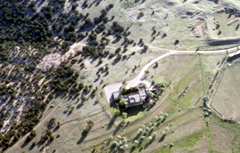
Lower Arroyo Hondo Pueblo
Galisteo Basin Sites
- Lamy Jct
- Lower Arroyo Hondo Pueblo
- El Camino Real
- Chamisa Locita
- El Crestón
- Espinoso Ridge Pueblo
- La Cienega Pueblo (LA 3)
- La Cienega Pithouse Village
- La Cieneguilla Pueblo (LA 16)
- La Cieneguilla Petroglyphs
- Manzanares Pueblo
- Paa-ko
- Petroglyph Hill
- Pueblo Blanco
- Pueblo Colorado
- Pueblo Galisteo
- Pueblo Largo
- Pueblo San Cristóbal
- Pueblo San Lazaro
- Pueblo Shé
- Rote Chert Quarry
- San José de Las Huertas
- Upper Arroyo Hondo Pueblo
- Pueblo San Marcos
Lower Arroyo Hondo Pueblo (LA 12) is a large aggregated Puebloan settlement of the Late Coalition and Early Classic periods in the traditional Rio Grande chronology.
The site is on the edge of the canyon of Arroyo Hondo, with good views of the surrounding land on all sides. The relatively flat land adjacent to the village would have been useful for agriculture. The placement affords an expansive view of areas to the north, west, and south, possibly useful for monitoring the activities of people or potential game animals nearby. Water was formerly available almost year-round from Arroyo Hondo and the springs that feed it. Known sites just east and northeast along the arroyo include Puebloan sites with agricultural features and possibly short-term habitations. Also within view of the large pueblo are two sites that contain stone circles thought to be shrine features—these may have been important in the ritual life of the village. The open woodland setting may have been altered in prehistoric times by cutting of large timber for roomblock construction.

An extensive excavation project was conducted by the School for American Research in the 1970s. A series of publications on various material categories and architecture was produced by the SAR. LA 12 is significant in the late prehistory of the northern Rio Grande, given its relatively early expression of population aggregation; its continued use of black-on-white ceramics alongside what could be termed a fair explosion of glaze ware use in the Galisteo Basin, just to the south; an apparently serious range of skeletal pathologies and morbidity patterns associated with malnutrition and limited diet; the association of agricultural intensity with changes in climatic patterns through time; and several other topics. Lower Arroyo Hondo Pueblo is also part of an important cultural landscape on a small scale. Its immediate predecessor, Upper Arroyo Hondo Pueblo, is about one mile upstream on the same drainage, and numerous smaller Puebloan and Archaic sites are known along the hillsides and arroyo banks in between, as well as in the surrounding hills and plains. These cultural manifestations include two probable ceremonial sites that have open stone circles on hilltops overlooking LA 12. On a larger scale, the site is associated with the Galisteo Basin, ancestral Tewa, and biscuit ware archaeological areas to the south and north.
Arroyo Hondo Pueblo was listed in the National Register of Historic Places in 2007. The site is currently owned by the Archaeological Conservancy, based in Albuquerque, New Mexico. Ownership adjacent to the site is private.

© New Mexico Office of Archaeological Studies, a division of the New Mexico Department of Cultural Affairs.
The Center for New Mexico Archaeology
7 Old Cochiti Road
Santa Fe, NM 87507
505-476-4404
Fax: 505-476-4448

